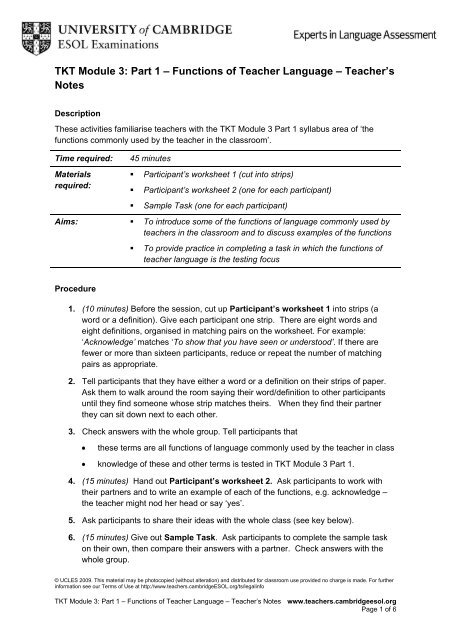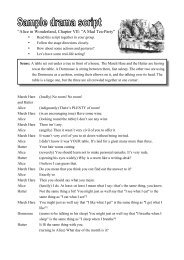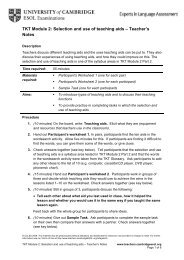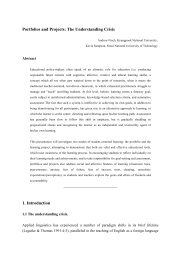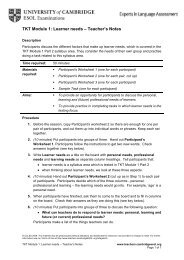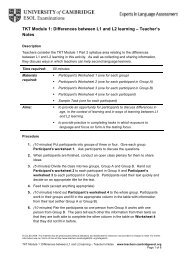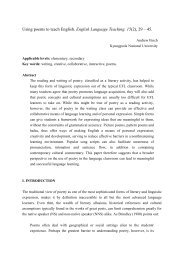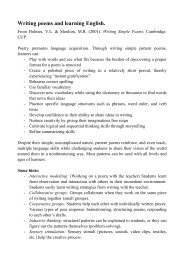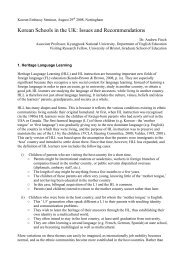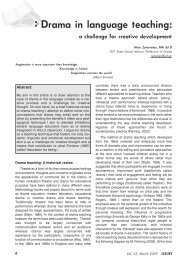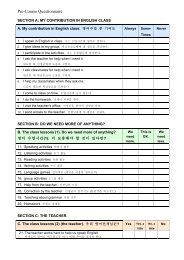TKT Module 3: Part 1 â Functions of Teacher Language ... - Finchpark
TKT Module 3: Part 1 â Functions of Teacher Language ... - Finchpark
TKT Module 3: Part 1 â Functions of Teacher Language ... - Finchpark
- No tags were found...
Create successful ePaper yourself
Turn your PDF publications into a flip-book with our unique Google optimized e-Paper software.
<strong>TKT</strong> <strong>Module</strong> 3: <strong>Part</strong> 1 – <strong>Functions</strong> <strong>of</strong> <strong>Teacher</strong> <strong>Language</strong> – <strong>Teacher</strong>’sNotesDescriptionThese activities familiarise teachers with the <strong>TKT</strong> <strong>Module</strong> 3 <strong>Part</strong> 1 syllabus area <strong>of</strong> ‘thefunctions commonly used by the teacher in the classroom’.Time required:Materialsrequired:45 minutes• <strong>Part</strong>icipant’s worksheet 1 (cut into strips)• <strong>Part</strong>icipant’s worksheet 2 (one for each participant)• Sample Task (one for each participant)Aims: • To introduce some <strong>of</strong> the functions <strong>of</strong> language commonly used byteachers in the classroom and to discuss examples <strong>of</strong> the functions• To provide practice in completing a task in which the functions <strong>of</strong>teacher language is the testing focusProcedure1. (10 minutes) Before the session, cut up <strong>Part</strong>icipant’s worksheet 1 into strips (aword or a definition). Give each participant one strip. There are eight words andeight definitions, organised in matching pairs on the worksheet. For example:‘Acknowledge’ matches ‘To show that you have seen or understood’. If there arefewer or more than sixteen participants, reduce or repeat the number <strong>of</strong> matchingpairs as appropriate.2. Tell participants that they have either a word or a definition on their strips <strong>of</strong> paper.Ask them to walk around the room saying their word/definition to other participantsuntil they find someone whose strip matches theirs. When they find their partnerthey can sit down next to each other.3. Check answers with the whole group. Tell participants that• these terms are all functions <strong>of</strong> language commonly used by the teacher in class• knowledge <strong>of</strong> these and other terms is tested in <strong>TKT</strong> <strong>Module</strong> 3 <strong>Part</strong> 1.4. (15 minutes) Hand out <strong>Part</strong>icipant’s worksheet 2. Ask participants to work withtheir partners and to write an example <strong>of</strong> each <strong>of</strong> the functions, e.g. acknowledge –the teacher might nod her head or say ‘yes’.5. Ask participants to share their ideas with the whole class (see key below).6. (15 minutes) Give out Sample Task. Ask participants to complete the sample taskon their own, then compare their answers with a partner. Check answers with thewhole group.© UCLES 2009. This material may be photocopied (without alteration) and distributed for classroom use provided no charge is made. For furtherinformation see our Terms <strong>of</strong> Use at http://www.teachers.cambridgeESOL.org/ts/legalinfo<strong>TKT</strong> <strong>Module</strong> 3: <strong>Part</strong> 1 – <strong>Functions</strong> <strong>of</strong> <strong>Teacher</strong> <strong>Language</strong> – <strong>Teacher</strong>’s Notes www.teachers.cambridgeesol.orgPage 1 <strong>of</strong> 6
7. (5 minutes) Round up to summarise points covered. Ask participants:• What is the <strong>TKT</strong> <strong>Module</strong> 3 syllabus area for this lesson? (functionscommonly used by the teacher in the classroom)• What are candidates being tested on? (Candidates are tested on theirknowledge <strong>of</strong> and ability to identify a range <strong>of</strong> classroom functions used byteachers)• How can candidates prepare for this area <strong>of</strong> the syllabus? (Candidates canstudy the list <strong>of</strong> examples <strong>of</strong> teacher language in the <strong>TKT</strong> Glossary which is onthe Cambridge ESOL website).© UCLES 2009. This material may be photocopied (without alteration) and distributed for classroom use provided no charge is made. For furtherinformation see our Terms <strong>of</strong> Use at http://www.teachers.cambridgeESOL.org/ts/legalinfo<strong>TKT</strong> <strong>Module</strong> 3: <strong>Part</strong> 1 – <strong>Functions</strong> <strong>of</strong> <strong>Teacher</strong> <strong>Language</strong> – <strong>Teacher</strong>’s Notes www.teachers.cambridgeesol.orgPage 2 <strong>of</strong> 6
<strong>TKT</strong> <strong>Module</strong> 3: <strong>Part</strong> 1 – <strong>Functions</strong> <strong>of</strong> <strong>Teacher</strong> <strong>Language</strong> – AnswerKeysKey to Procedure Step 3Acknowledge: to show that you have seen or understoodConvey meaning: to express or communicate meaningElicit: to ask targeted questions to get learners to tell you what they knowNarrate: to tell a story or talk about something that happenedPraise: to tell someone that they have done wellPrompt: to help learners think <strong>of</strong> ideas or to remember a wordRecast: to reword a sentence or phrase to improve itSimplify: to make something easierKey to <strong>Part</strong>icipant’s worksheet 2Acknowledge: the teacher nods her head or say ‘yes’.Convey meaning: something which is huge is something very, very big, an elephant ishuge.Elicit: What kinds <strong>of</strong> fruit are oranges and lemons?Narrate: Last year I went to France for my summer holiday…Praise: Very good, Well done, That’s excellent work.Prompt: It’s the opposite <strong>of</strong> big or huge. It is very small. It begins with a T.Recast: Student: I’m go to the bank today. <strong>Teacher</strong>: I’m going to the bank todaySimplify: ‘I’d like you to look at the second exercise on the right there, exercise number2 on page 12 <strong>of</strong> your coursebook’. To simplify this, the teacher could say ‘Open yourbook. Look at exercise 2, page 12, please’.Key to Sample Task1. A 2. B 3. E 4. D 5. A 6. C 7.C 8 B 9E© UCLES 2009. This material may be photocopied (without alteration) and distributed for classroom use provided no charge is made. For furtherinformation see our Terms <strong>of</strong> Use at http://www.teachers.cambridgeESOL.org/ts/legalinfo<strong>TKT</strong> <strong>Module</strong> 3: <strong>Part</strong> 1 – <strong>Functions</strong> <strong>of</strong> <strong>Teacher</strong> <strong>Language</strong> – Answer Keyswww.teachers.cambridgeesol.orgPage 3 <strong>of</strong> 6
<strong>TKT</strong> <strong>Module</strong> 3: <strong>Part</strong> 1 – <strong>Functions</strong> <strong>of</strong> <strong>Teacher</strong> <strong>Language</strong> –<strong>Part</strong>icipant’s Worksheet 1AcknowledgeTo show that you have seen or understoodConvey meaningTo express or communicate meaningElicitTo ask targeted questions to get learners to tell you what they knowNarrateTo tell a story or talk about something that happenedPraiseTo tell someone that they have done wellPromptTo help learners think <strong>of</strong> ideas or to remember a wordRecastTo reword a sentence or phrase to improve itSimplifyTo make something easier© UCLES 2009. This material may be photocopied (without alteration) and distributed for classroom use provided no charge is made. For furtherinformation see our Terms <strong>of</strong> Use at http://www.teachers.cambridgeESOL.org/ts/legalinfo<strong>TKT</strong> <strong>Module</strong> 3: <strong>Part</strong> 1 – <strong>Functions</strong> <strong>of</strong> <strong>Teacher</strong> <strong>Language</strong> – <strong>Part</strong>icipant’s Worksheet 1www.teachers.cambridgeesol.orgPage 4 <strong>of</strong> 6
<strong>TKT</strong> <strong>Module</strong> 3: <strong>Part</strong> 1 – <strong>Functions</strong> <strong>of</strong> <strong>Teacher</strong> <strong>Language</strong> –<strong>Part</strong>icipant’s Worksheet 2Work with a partner and provide an example for each <strong>of</strong> these functions <strong>of</strong> teacherlanguage in the classroom1. Acknowledge: to show that you have seen or understood.Example: - the teacher might nod her head or say ‘yes’.2. Convey meaning: to express or communicate meaning.Example:3. Elicit: to ask targeted questions to get learners to give informationExample:4. Narrate: to tell a story or talk about something that happenedExample:5. Praise: to tell someone that they have done wellExample:6. Prompt: to help learners think <strong>of</strong> ideas or to remember a wordExample:7. Recast: to reword a sentence or phrase to improve itExample:8. Simplify: to make something easierExample:© UCLES 2009. This material may be photocopied (without alteration) and distributed for classroom use provided no charge is made. For furtherinformation see our Terms <strong>of</strong> Use at http://www.teachers.cambridgeESOL.org/ts/legalinfo<strong>TKT</strong> <strong>Module</strong> 3: <strong>Part</strong> 1 – <strong>Functions</strong> <strong>of</strong> <strong>Teacher</strong> <strong>Language</strong> – <strong>Part</strong>icipant’s Worksheet 2www.teachers.cambridgeesol.orgPage 5 <strong>of</strong> 6
<strong>TKT</strong> <strong>Module</strong> 3: <strong>Part</strong> 1 – <strong>Functions</strong> <strong>of</strong> <strong>Teacher</strong> <strong>Language</strong> – SampleTaskFor questions 1–9, match each example <strong>of</strong> teachers’ classroom language with its functionlisted A–F. You need to use some options more than once.<strong>Functions</strong>ABCDEgiving instructionscorrecting student errorseliciting vocabularynarratingexplaining about languageExamples <strong>of</strong> teachers’ classroom languageT = teacher S = student1 T: Turn your chairs round and sit back to back2 S: The man is working home.T: Pronunciation.S: Er…he’s walking home.T: That’s right.3 T: The present perfect is also used to talk about recent events.4 T: While Maria was working the thief took her handbag.S: Where was her handbag?T: Under her chair. Anyway then she turned round and …5 T: Read the postcard quickly and decide if the writer is enjoying his holiday.6 T: What’s the man doing in the picture?S: He’s going up the mountainT: Yes, and do you know another word for ‘going up’?7 T: If you don’t sleep well, how do you feel?8 S: I spoke with grandmummy.T: You spoke with your grandma.S: Yes, I spoke with my grandma.9 T: This sound is produced by putting your tongue against your teeth.© UCLES 2009. This material may be photocopied (without alteration) and distributed for classroom use provided no charge is made. For furtherinformation see our Terms <strong>of</strong> Use at http://www.teachers.cambridgeESOL.org/ts/legalinfo<strong>TKT</strong> <strong>Module</strong> 3: <strong>Part</strong> 1 – <strong>Functions</strong> <strong>of</strong> <strong>Teacher</strong> <strong>Language</strong> – Sample Taskwww.teachers.cambridgeesol.orgPage 6 <strong>of</strong> 6


